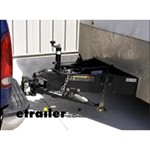
How Does Bar Style Friction Sway Control Work
Question:
What is the maximum force that the anti-sway bar can induce into the front A-Frame of a trailer tongue structure to which it is mounted? Specifically, this would be the force induced as a reactive load into the A-Frame member, as the reactive load used to reduce the swaying of the trailer, oriented perpendicular to the mounting surface of the mounting plates provided to mount the device to the trailer tongue A-Frame. There appears to be a lateral component of this force acting perpendicular to the A-Frame arm, as well as a longitudinal one attempting to lengthen or shorten the A-Frame arm. As the longitudinal component of force is acting at a distance above the surface of the A-Frame, a bending moment is induced into the A-Frame arm by this device, is it not? Can it be locked up solid, or is there a safety or some other limit or stop on the friction generating adjustment assembly that prevents a complete lock-up of the device? How does the installer or user determine the amount of friction that may be safely applied, or determine the amount for frictional force being generated? What is the effect of this load attempting to bend the A-Frame arms in order to provide the stabilizing force to counter the swaying motion? The mounting pads appear to be 1-1/2inch wide at best it doesnt appear that this will provide much resistance to this bending moment. What is the effect on the A-Frame member for simply maneuvering the trailer in city traffic, or navigating in a campsite, for example with the unit installed? Arent these same reactive forces being generated to counter swaying also going to be generated by simple maneuvering of the trailer? Who manufactures this device you are offering on your website?
asked by: James K
Expert Reply:
A friction sway bar such as # 17200 manufactured by Curt, does not exert any force on the trailer. The trailer will be putting force on it and transfer it to the tow vehicle. But ultimately, the amount of force is dependent on how you have the unit adjusted (Newton or foot pound range is not provided).
I would not say there is any bending force being applied or enough to actually bend the trailer frame. But yes, the force is not a straight line due to the 50 degree angle of most A-frame trailers.
You would never be able to get the unit tight enough to lock it up. A swaying trailer or making a turn would provide enough force to overcome that and then brake the unit. The amount of friction is something that has to be determined by taking a few test runs and then making small adjustments until you get it to where you want it.
The assembly that attaches to the trailer is closer to 3 inches square, not 1-1/2 inches.
The vehicle making turns can easily overcome the sway control because it applies much more force than average sway caused by wind or a passing vehicle. But with these systems you have to disengage and/or remove them when backing up. This is because when backing up you are putting a different direct of force on the unit that it is not designed to handle.
This unit is made by Curt. Others are made by Pro Series, Reese, Ultra-Fab, and Draw-Tite. I have linked a help article on weight distribution and sway control for you.

Product Page this Question was Asked From
Curt Friction Sway Control for Weight Distribution Systems
- Accessories and Parts
- Weight Distribution Hitch
- Sway Control Parts
- CURT
more information >
Featured Help Information
Instructions
Miscellaneous Media

Continue Researching
- Shop: Equal-i-zer Weight Distribution System w/ 4-Point Sway Control - 12,000 lbs GTW, 1,200 lbs TW
- Shop: Equal-i-zer Weight Distribution System w/ 4-Point Sway Control - 14,000 lbs GTW, 1,400 lbs TW
- Shop: Replacement L-Pins and Clips for Equal-i-zer Weight Distribution Systems - 6K to 14k - Qty 2
- Shop: Sway Bracket Jackets for Equal-i-zer Weight Distribution Systems - Qty 2
- Q&A: Will The Equal-i-Zer Sway Bracket Jackets Work W/ The Replacement L-Pins & Clips?
- Q&A: Can Weight Distribution be Used on Vehicle with Auto Leveling Suspension
- Q&A: How Tight Should Curt Friction Sway Control # 17200 Be Adjusted
- Shop: Equal-i-zer Weight Distribution w/ 4-Point Sway Control - No Shank - 12,000 lbs GTW, 1,200 lbs TW
- Shop: 1-7/8" 12pt Thin Walled Socket - 3/4" Drive - Chromium-Vanadium Steel
- Shop: Equal-i-zer Weight Distribution System w/ 4-Point Sway Control - 6,000 lbs GTW, 600 lbs TW
- Shop: Trailer Hitch
- Search Results: andersen hitch
- Q&A: How Tight Should Bar Style Friction Sway Control Be
- Search Results: friction sway bar
- Video: Curt Weight Distribution - Sway Control Only - 17200 Review
- Shop: Brake Controller
- Search Results: redarc bracket
- Article: Which Sway Control Hitch is Right For Your Trailer?
- Q&A: How Can You Tell if a Friction Sway Control Bar is Too Tight
- Q&A: Recommendations for Reducing Noise On Fastway E2 Weight Distribution Hitch
- Q&A: Friction Sway Control Bars Make Loud Noises When Turning
- Video: Review of Curt 7-Way LED Trailer Light Adapter - C57003
- Shop: Trailer Wiring
- Search Results: red99fr
- Article: How to Measure for Trailer Hitch Drop
- Article: 5 Things to Know About Weight Distribution Hitches
- Shop: Towing Mirrors
- Shop: Suspension Enhancement
- Video: Choosing the Right Trailer Wiring
- Search Results: weight distribution hitch






